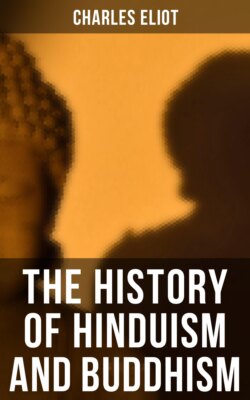Читать книгу The History of Hinduism and Buddhism - Charles Eliot - Страница 32
На сайте Литреса книга снята с продажи.
BOOK II EARLY INDIAN RELIGION
A GENERAL VIEW
ОглавлениеTable of Contents
In this book I shall briefly sketch the condition of religion in India prior to the rise of Buddhism and in so doing shall be naturally led to indicate several of the fundamental ideas of Hinduism. For few old ideas have entirely perished: new deities, new sects and new rites have arisen but the main theories of the older Upanishads still command respect and modern reformers try to justify their teaching from the ancient texts.
But I do not propose to discuss in detail the religion of the Vedic hymns for, so far as it can be distinguished from later phases, it looks backward rather than forward. It is important to students of comparative mythology, of the origins of religion, of the Aryan race. But it represents rather what the Aryans brought into India than what was invented in India, and it is this latter which assumes a prominent place in the intellectual history of the world as Hinduism and Buddhism. The ancient nature gods of the wind and the dawn have little place in the mental horizon of either the Buddha or Bhagavad-gîtâ and even when the old names remain, the beings who bear them generally have new attributes. Still, Vedic texts are used in modern worship and in many respects there is a real continuity of thought.
In the first chapter I enquire whether there is any element common to the religions of India and to the countries of Eastern Asia and find that the worship of nature spirits and the veneration of ancestors prevail throughout the whole of this vast region and have not been suppressed by Buddhism or Brahmanism. Then coming to the purely Indian sphere, I have thought it might not be amiss to give an epitome of such parts of Indian history as are of importance for religion. Next I endeavour to explain how the social institutions of India and the unique position acquired by the Brahman aristocracy have determined the character of Hindu religion—protean and yet unmistakeably Indian in all its phases—and I also investigate the influence of the belief in rebirth, which from the time of the Upanishads onwards dominates Indian thought. In the fourth and fifth chapters I trace the survival of some ancient ideas and show how many attributes of the Vedic gods can be found in modern deities who are at first sight widely different and how theories of salvation by sacrifice or asceticism or knowledge have been similarly persistent. In the sixth chapter I attempt to give a picture of religious life, both Brahmanic and non-Brahmanic, as it existed in India about the time when the Buddha was born. Of the non-Brahmanic sects which then flourished most have disappeared, but one, namely the Jains, has survived and left a considerable record in literature and art. I have therefore devoted a chapter to it here.
My object in this book is to discuss the characteristics of Indian religion which are not only fundamental but ancient. Hence this is not the place to dwell on Bhakti or relatively modern theistic sects, however great their importance in later Hinduism may be.
